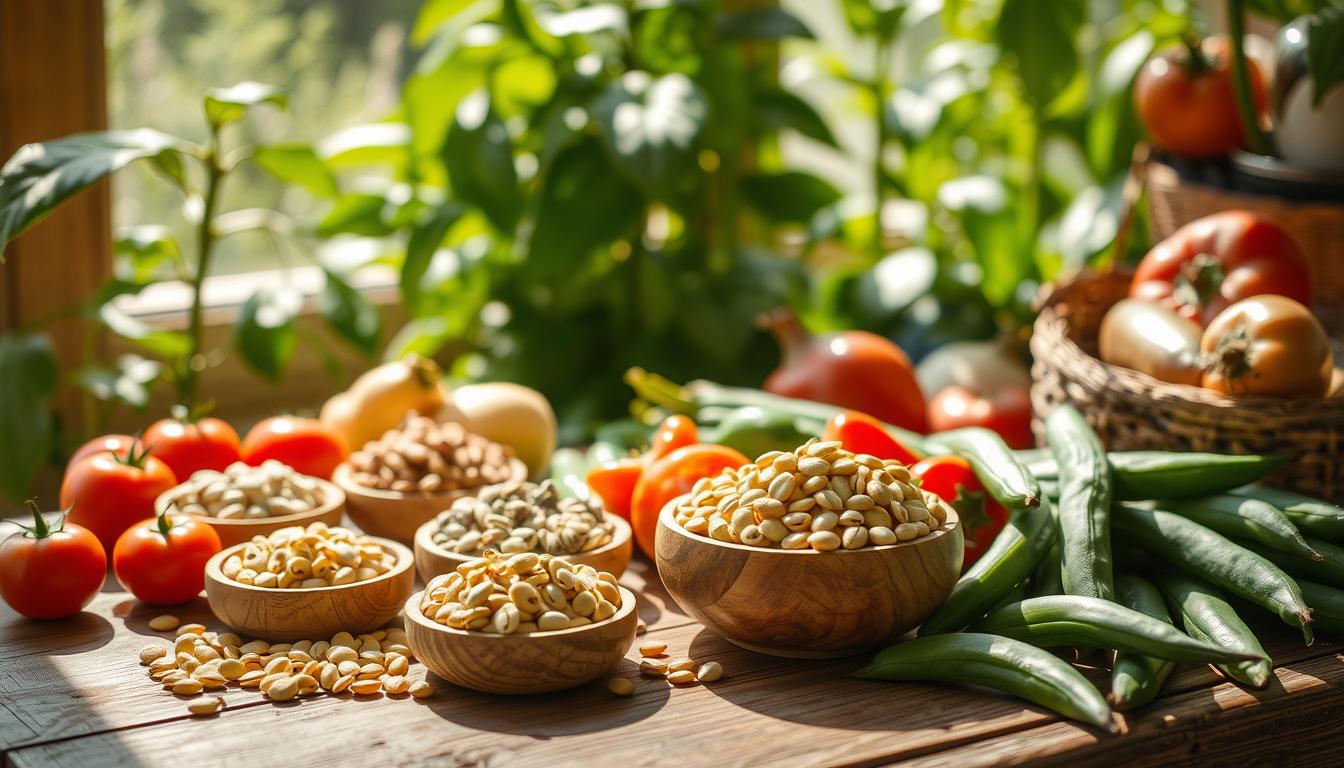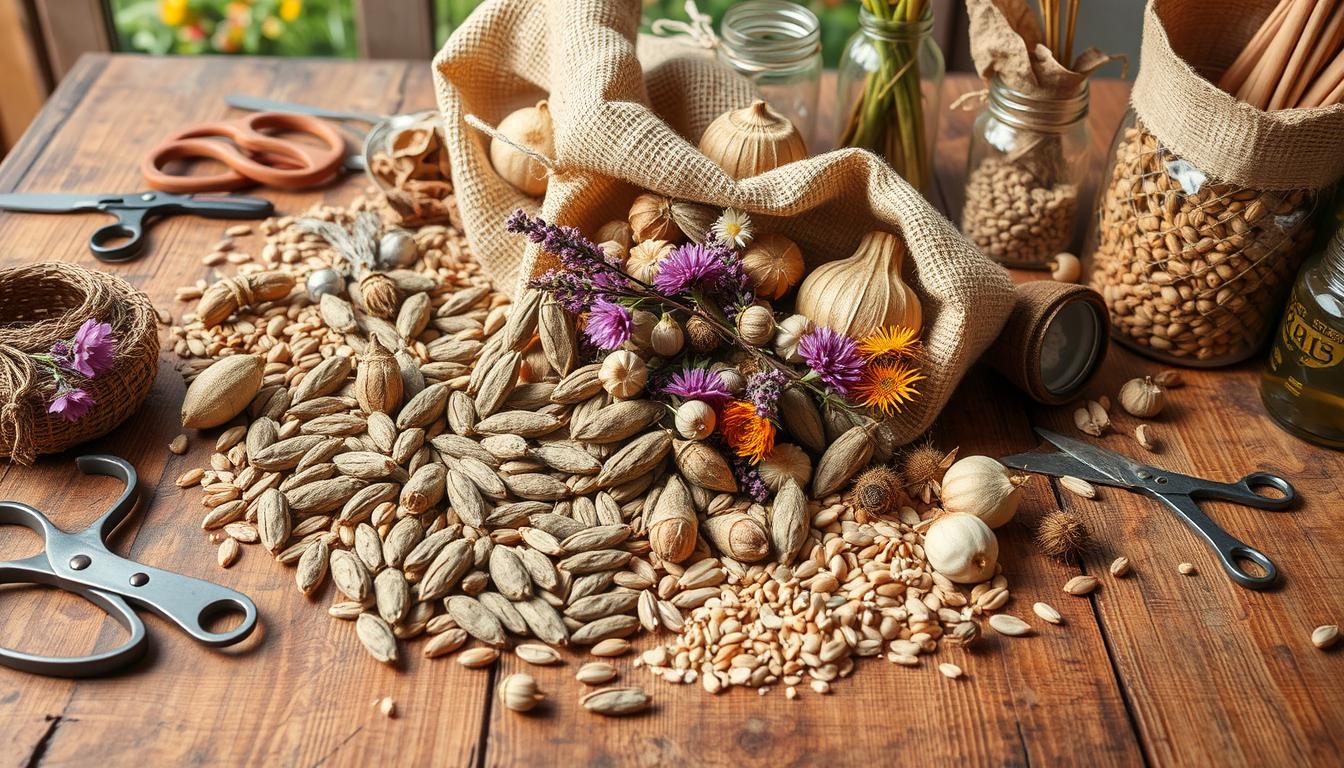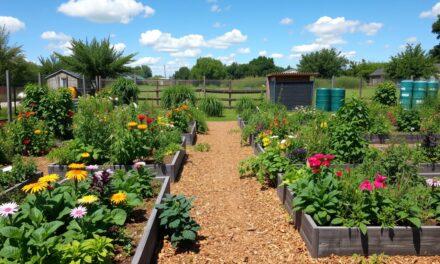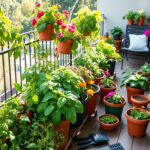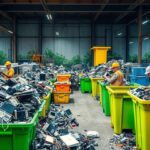Did you know only 10-20% of home gardeners save seeds? This shows a big chance for more sustainable gardening. I’m excited to share my seed saving guide. It will change how you grow vegetables and keep heirloom seeds.
Seed saving is more than a hobby. It helps keep your garden’s genetic diversity alive. About 40% of gardeners now save seeds for self-sufficiency. Open-pollinated crops are key for seeds that grow true to their kind.
I started saving seeds to save money and keep unique plant varieties. Saving seeds can cut gardening costs by 50-80% each year. Heirloom varieties add 75% of genetic diversity to our food, making each saved seed important.
This guide is for both new and seasoned gardeners. You’ll learn to start your own sustainable seed collection. You’ll discover how to harvest and save the best seeds for next year’s garden.
Understanding Open-Pollinated and Hybrid Varieties
Seed saving connects gardeners to their past. It’s a world where open-pollinated varieties are key to keeping seeds diverse. Let’s explore the world of seed genetics and how they reproduce.
What Are Open-Pollinated Plants
Open-pollinated plants show nature’s genetic variety at its best. They breed true, meaning their seeds grow into plants just like them. These plants adapt well to local conditions, becoming stronger over time.
- Maintain genetic diversity.
- Adapt to local environments.
- Breed consistently true to type.
Why Avoid Hybrid Seeds for Saving
Hybrid seeds are great at first but hard for seed savers. They have hybrid vigor, growing well at first. But, their seeds don’t grow true, so you need to buy new seeds every year.
Preserving open-pollinated varieties is key to maintaining agricultural biodiversity.
Choosing the Right Parent Plants
Choosing parent plants for saving seeds is important. Pick strong, healthy plants with good traits. Self-pollinating crops like tomatoes, beans, and lettuce are great for beginners.
Here is a comparison chart:
| Seed Type | Characteristics | Seed Saving Potential |
| Open-Pollinated | Genetically diverse | High. |
| Hybrid | Uniform, high-yielding | Low. |
Learning these basics helps you save and grow your favorite plants. This way, you help keep seed diversity alive.
Essential Seed Saving Guide for Beginners
Starting your seed saving journey is exciting for home gardeners. It’s both an art and a science. Knowing the basics of a seed saving guide is key to preserving your favorite plants’ qualities.
Seed Saving Techniques For Beginners
When starting, picking healthy plants is important. Seeds from strong, disease-free plants grow the best7. Choose open-pollinated varieties for seeds that match the parent plant.
- Choose healthy, mature plants for seed collection.
- Select open-pollinated varieties for consistent results.
- Understand your crop’s pollination type.
Vegetables have different seed storage lifespans. Here’s a quick guide:
| Seed Longevity | Vegetable Types |
| 1-2 Years | Onion, Parsnip. |
| 1-3 Years | Bean, Carrot, Pepper. |
| 4-5 Years | Tomato, Cucumber, Egg Plan. |
Seed Saving Expert,
Seed saving is about preserving genetic diversity and connecting with our agricultural heritage.
To succeed, learn to test seed germination. A full germination rate of 100% means your seeds are ready. Rates between 70-90% mean you can plant them more densely.
Pro Tip: Check seed dryness by bending thin seeds or tapping larger seeds. If they snap or shatter, they’re ready for storage.
Harvesting Seeds from Different Vegetables
Learning to harvest seeds is key for gardeners wanting to save their favorite vegetables. It’s important to know how different plants behave when saving seeds. I’ve found that each type of vegetable needs its own method for collecting seeds.
Vegetable Seed Harvesting Guide
Fruiting Vegetables Seed Collection
For vegetables like tomatoes and peppers, timing is everything. Self-pollinating vegetables like these need little extra care. Tomatoes, for example, need a special fermentation step to keep their seeds alive.
- Wait until fruits are fully ripe.
- Ferment seeds for 2-3 days.
- Use a fine-mesh strainer to separate viable seeds.
Leafy Greens and Seed Saving
Leafy greens need a different method for seed harvesting. You must let these plants bolt – grow beyond the edible stage to produce seeds.
Some good open-pollinated varieties include:
| Vegetable Type | Recommended Varieties |
| Lettuce | Open-pollinated varieties that maintain genetic consistency. |
| Spinach | Varieties that preserve local adaptability. |
Root Vegetable Seed Collection
Root vegetables have their own challenges in seed saving. Biennial crops like carrots and beets need two growing seasons to produce seeds.
Seed savers should:
- Allow root vegetables to bolt completely.
- Wait for seed heads to develop fully.
- Collect and dry seeds carefully.
Pro Tip: Proper seed storage can maintain viability for up to 5 years when done correctly.
By learning these seed harvesting techniques, you can create a sustainable garden cycle. This cycle preserves genetic diversity and cuts down on gardening costs.
The Fermentation Process for Wet Seeds
Harvesting seeds from wet-seeded vegetables needs a special method called fermentation. This method is key for saving seeds from fruits like tomatoes, cucumbers, and peppers. These fruits have a protective gel coating around their seeds.
Seed Fermentation Process
Fermentation is more than just cleaning seeds. It breaks down the protective coating and gets rid of diseases. Done right, it boosts seed viability and how long they can be stored. Seed Saving Expert,
Fermentation is nature’s way of preparing seeds for long-term survival.
Fermentation Step-by-Step
- Collect ripe fruits with mature seeds.
- Mash the fruits in a container.
- Add water and let the mixture sit.
- Maintain temperature around 70°F (21°C).
- Allow fermentation for approximately 3 days.
Good seeds will sink to the bottom during fermentation. Rinse the seeds several times – about five – until the water is clear.
Vegetable Type, Fermentation Time and Ideal Temperature:
| Vegetable Type | Fermentation Time | Ideal Temperature |
| Tomatoes | 2-3 Days | 70°F (21°C). |
| Cucumbers | 3-4 Days | 70-75°F (21-24°C). |
| Peppers | 2-3 Days | 70°F (21°C). |
Choose seeds from a diverse group. For tomatoes, pick seeds from 130 to 160 mother plants. This ensures genetic diversity.
Pro Tip: Always watch the fermentation closely. Avoid temperatures over 95°F, as it can harm seed viability.
Proper Techniques for Dry Seed Collection
Seed harvesting is an art that needs precision and attention to detail. In my gardening years, I’ve learned that saving flower and vegetable seeds is complex. It involves understanding the dry seed collection process.
Dry Seed Harvesting Techniques
Timing Your Harvest
Knowing when to harvest seeds is key for successful seed saving. Seeds are ready when their pods turn from green to brown and dry completely on the plant. For plants like lettuce and sunflowers, let seed heads dry fully on the plant before harvesting.
- Wait until pods turn brown and brittle.
- Check that seeds can rattle inside pods.
- Harvest on a dry, sunny day.
Processing Methods
Seed processing includes several important techniques. For legumes like beans and peas, leave pods on the plant until they’re dry enough for seeds to rattle when shaken. Be careful not to over-dry, as it can cause seeds to scatter. Anonymous Gardener said,
Patience is the gardener’s greatest tool in seed collection.
Cleaning and Sorting
Proper cleaning is essential for high-quality seed storage. Use paper envelopes or glass jars to prevent moisture buildup. A simple germination test can check seed viability by placing a few seeds on a wet paper towel and looking for sprouting.
Seed Type and Viability Period:
| Seed Type | Viability Period |
| Tomato Seeds | Up to 6 years. |
| Onion Seeds | Approximately 1 year. |
Remember, successful seed harvesting takes practice. Each season teaches you more about saving seeds from your garden.
Preventing Cross-Pollination in Your Garden
To keep open-pollinated varieties pure, you need a good garden plan. It’s all about stopping cross-pollination between related plants. Here are some tips to keep your seeds true to their type.
Every plant pollinates differently, affecting seed saving. Self-pollinators like peas and tomatoes are simpler to handle. But, cross-pollinators like melons and squash need more careful planning.
- Spatial Isolation: Plant different varieties at least 100-300 feet apart.
- Temporal Isolation: Stagger planting times to prevent simultaneous flowering.
- Physical Barriers: Use mesh covers or isolation bags to protect flowers.
Choose healthy plants for seed saving. For most, use multiple plants to keep genetic diversity. Self-pollinators like tomatoes can save seeds with just a few plants. My gardening motto said,
Seed saving is an art of patience and precision.
Remember to label your saved seeds with cross-pollination notes. This helps keep track of your seeds’ genetic purity. It ensures your seed diversity stays strong.
Best Practices for Seed Storage and Viability
Keeping your saved seeds ready for planting needs careful storage. It’s a mix of science and skill to keep seeds good for next year’s garden.
Choosing the Right Storage Containers
Start by picking the right containers for your seeds.
Each type of seed needs a special container:
- Paper envelopes for seeds that are drying.
- Airtight glass jars for dry seeds.
- Plastic containers with tight lids.
Temperature and Humidity Management
Keeping the right conditions is key for seed storage. The best temperature is about 42°F (5.6°C), with very low humidity. Try to keep the total of temperature and humidity under 100.
Crop Type and Storage lifespan:
| Crop Type | Storage Lifespan |
| Pumpkin Seeds | 4-6 Years. |
| Onion Seeds | 1-2 Years. |
| Basil Seeds | 3-5 Years. |
Smart Organization Techniques
Labeling is key for keeping seeds organized.
I suggest making a detailed tracking system with:
- Seed variety name.
- Date of collection.
- Estimated viability period.
Use vacuum-sealed bags or silica gel packets to keep moisture down. Always test seeds before planting to check if they’re good.
Proper seed storage is the key to preserving your garden’s future.
Pro Tip: Store seeds in a cool, dark place to keep them fresh and ready to grow.
Understanding Plant Life Cycles: Annuals vs. Biennials
Seed saving is all about knowing how plants grow. In my guide, I’ll explain the big difference between annual and biennial plants. This is key for saving vegetable seeds. Annual plants grow, flower, and produce seeds in just one year.
You might save seeds from these annuals:
- Beans
- Squash
- Broccoli
- Tomatoes
Biennials need two years to grow. They spend the first year building roots and storing energy. The second year, they flower and make seeds.
Some biennial veggies you might save seeds from are:
- Beets
- Chard
- Carrots
- Cabbage
Knowing these life cycles is key for saving seeds. Some plants are annuals in cool places but perennials in warm ones. This info helps gardeners plan better. Gardening wisdom can say,
Know your plant’s life cycle, and you’ll master the art of seed saving.
Try both annual and biennial seed saving. It will improve your gardening and seed collection skills.
Building a Sustainable Seed Bank at Home
Starting a home seed bank is a great way to keep plant diversity alive. It helps your garden grow strong and supports local farming. By saving heirloom seeds, you build a valuable collection.
My seed saving journey started with the importance of saving plant varieties. A good seed bank protects your garden’s unique plants. Saving seeds keeps our agricultural diversity alive.
- Collect seeds from healthy, robust plants.
- Store seeds in airtight containers.
- Maintain consistent cool temperatures.
- Organize seeds by type and planting season.
Storing your seeds right is key. They can last up to 3 years with the right care. For long-term storage, use containers made for food. Keep them cool, between 40-45°F, to keep them viable. Local seed saving community said,
Seed saving is an act of preserving our agricultural heritage.
Joining seed exchanges can grow your collection fast. Connecting with local gardeners lets you find rare seeds. It helps build a strong, sustainable farm system.
Storage Method and seed viability:
| Storage Method | Seed Viability |
| Mylar Bags | Up to 10 years. |
| Paper Envelopes | Short-term storage. |
| Airtight Containers | Long-term preservation. |
About 75% of seeds from healthy plants can be saved and stored well. Your seed bank is a living proof of our commitment to diversity and sustainability.
Conclusion
Reflecting on our seed saving guide, I see how vital it is to keep seed diversity alive. Sadly, 70% of food crop varieties have vanished after World War II. This loss highlights the key role gardeners have in saving our genetic heritage. By mastering seed saving, we protect the variety of crops we grow.
Seed saving is not just a gardening skill; it connects us to our farming past. It also helps us grow food in a way that’s good for the planet. Today’s farming often focuses on a few standard types, which hurts our genetic variety. By saving seeds, we protect rare plant types that might vanish.
My experience with seed saving has shown me its power. Saving seeds the right way helps our food system grow stronger. Each seed we save is a beacon of hope for future harvests and a pledge to our farming legacy.
I encourage you to start seed saving. It’s a way to bond with nature, support local farmers, and keep seed variety alive for future generations. Your garden can be a safe haven for genetic diversity, one seed at a time.
Frequently Ask Questions (FAQ)
What is seed saving, and why should I do it?
Seed saving means collecting and storing seeds from your garden for later use. It’s key for saving money and growing plants that fit your local climate. It also helps keep plant diversity alive and boosts your gardening independence.
Which types of seeds are best for beginners to save?
Beginners should start with easy seeds like tomatoes, peppers, beans, and flowers like marigolds and zinnias. These are simple to collect and great for learning.
What’s the difference between open-pollinated and hybrid seeds?
Open-pollinated seeds keep their traits when replanted. Hybrid seeds don’t. Open-pollinated seeds are best for saving because they let you keep specific traits over time.
How do I prevent cross-pollination in my seed-saving garden?
To avoid cross-pollination, separate plants, use barriers, and plan planting times. Knowing how different plants pollinate is key to keeping seeds pure.
What are the best conditions for storing seeds?
Keep seeds in a cool, dry spot with steady temperatures. Use sealed containers and silica gel to control moisture. Stay away from sunlight. This way, seeds can last several years.
How can I tell if my saved seeds are still good?
Do a germination test by dampening paper towels and placing seeds on them. Keep them warm and check after a week. Most seeds stay viable for 2-3 years with proper storage.
Can I save seeds from grocery store produce?
No, it’s not a good idea. Many store-bought fruits and veggies are hybrids or treated to stop germination. Seeds from local, organic, or farmers market produce work better.
What is seed fermentation, and why is it necessary?
Seed fermentation is for seeds from wet fruits like tomatoes and cucumbers. It removes pulp, kills diseases, and boosts germination by breaking down seed coatings.
How can I participate in seed exchanges?
Join local seed libraries, gardening clubs, or online groups. These places let you trade unique seeds, increase diversity, and meet other gardeners.
Are there any legal considerations with seed saving?
Be careful with patented or commercial hybrid seeds. Some have rules on saving seeds. Stick to open-pollinated and heirloom seeds, which usually don’t have these issues.


